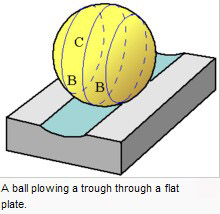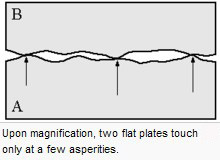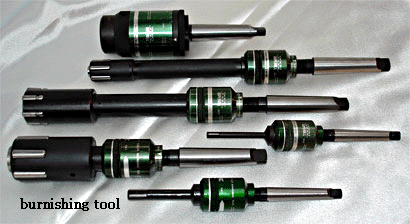1. Mechanics of Burnishing
To understand burnishing, first look at the simple case of a hardened ball on a flat plate. If the ball is pressed directly
into the plate, stresses develop in both objects around the area where they contact. As the this normal force increases,
both the ball and the plate's surface deform.
The deformation caused by the hardened ball is different depending on the magnitude of the force pressing against it.
If the force on it is small, when the force is released both the ball and plate's surface will return to their original,
undeformed shape. In this case, the stresses in the plate are always less than the yield strength of the material, so the deformation is purely elastic. Since it was given that the flat plate is softer than the ball, the plate's surface will always deform more. If a larger force is used, their will also be plastic deformation and the plate's surface will be permanently altered. A bowl-shaped indentation will be left behind, surrounded by a ring of raised material that was displaced by the ball. The stresses between the ball and the plate are described in more detail by Hertzian stress theory.
Now consider what happens if the external force on the ball drags it across the plate. In this case, the force on the ball
can be decomposed into two component forces: one normal to the plate's surface, pressing it in, and the other tangential,
dragging it along. As the tangential component is increased, the ball will start to slide along the plate. At the same
time, the normal force will deform both objects, just as with the static situation. If the normal force is low, the ball
will rub against the plate but not permanently alter its surface. The rubbing action will create friction and heat,
but it will not leave a mark on the plate. However, as the normal force increases, eventually the stresses in the
plate's surface will exceed its yield strength. When this happens the ball will plow through the surface and create
a trough behind it. The plowing action of the ball is burnishing.
Upon magnification, two flat plates touch only at a few asperities.Burnishing also occurs on surfaces that conform to
each other, such as between two flat plate, but it happens on a microscopic scale. Even the smoothest of surfaces will
have imperfections if viewed at a high enough magnification. The imperfections that extend above the general form of a
surface are called asperities, and they can plow material on another surface just like the ball dragging along
the plate. The combined effect of many of these asperities produce the smeared texture that is associated with
burnishing.
2. Effects of Burnishing on Mechanical Components
Burnishing is normally undesirable in mechanical components for a variety of reasons, sometimes simply because its effects
are unpredictable. Even light burnishing will significantly alter the surface finish of a part. Initially the finish will
be smoother, but with repetitive sliding action, grooves will develop on the surface along the sliding direction. The
plastic deformation associated with burnishing will harden the surface and generate compressive residual stresses.
Although these properties are usually advantageous, excessive burnishing leads to sub-surface cracks which cause spalling,
a phenomenon where the upper layer of a surface flakes off of the bulk material.
Burnishing may also affect the performance of a machine. The plastic deformation associated with burnishing creates
greater heat and friction than from rubbing alone. This reduces the efficiency of the machine and limits its speed.
Furthermore, plastic deformation alters the form and geometry of the part. This reduces the precision and accuracy of
the machine. The combination of higher friction and degraded form often leads to a runaway situation that continually
worsens until the component fails.
To prevent burnishing, sliding must be avoided. In the areas of a machine that slide with respect to each other, roller
bearings can be inserted so that the components are in rolling contact instead of sliding. If sliding cannot be avoided,
then a lubricant should be added between the components. The purpose of the lubricant in this case is to separate
the components with a lubricant film so they cannot contact. The lubricant also distributes the load over a larger area,
so that the local contact forces are not as high. If there was already a lubricant, its film thickness must be increased;
usually this can be accomplished by increasing the viscosity of the lubricant.
3.Burnishing in Manufacturing
Burnishing is not always bad. If it occurs in a controlled manner, it can have desirable effects. Burnishing processes
are used in manufacturing to to improve the size, shape, surface finish, or surface hardness of a workpiece. It is
essentially a forming operation that occurs on a small scale. The benefits of burnishing often include: Combats
fatigue failure, prevents corrosion and stress corrosion, textures surfaces to eliminate visual defects, closes porosity,
creates surface compressive residual stress.
There are several forms of burnishing processes, the most common are roller burnishing and ball burnishing (ballizing).
In both cases, a burnishing tool rubs against the workpiece and plastically deforms its surface. The workpiece may be at
ambient temperature, or heated to reduce the forces and wear on the tool. The tool is usually hardened and coated with
special materials to increase its life.
Ball burnishing, or ballizing, is a replacement for other bore finishing operations such as grinding, honing, or polishing.
A ballizing tool consists of one or more over-sized balls that are pushed through a hole. The tool is similar to a broach,
but instead of cutting away material, it plows it out of the way.[1]
Ball burnishing is also used as a deburring operation. It is especially useful for removing the burr in the middle of
a through hole that was drilled from both sides.[1]
Roller burnishing, or surface rolling, is used on cylindrical, conical, or disk shaped workpieces. The tool resembles
a roller bearing, but the rollers are fixed so they slide against the workpiece surface instead of rolling. It is
simultaneously rotated and pressed into the workpiece. Typical applications for roller burnishing include hydraulic
system components, shaft fillets, and sealing surfaces.[2]
Burnishing also occurs to some extent in machining processes. In turning, burnishing occurs if the cutting tool is
not sharp, if a large negative rake angle is used, if a very small depth of cut is used, or if the workpiece material
is gummy. As a cutting tool wears, it becomes more blunt and the burnishing effect becomes more pronounced. In grinding,
since the abrasive grains are randomly oriented and some are not sharp, there is always some amount of burnishing.
This is one reason the grinding is less efficient and generates more heat than turning.
- Finished to a mirror surface in one pass
- Work hardening of the finished surface
- Quick-touch, fine-adjustment mechanism
- Low running cost
- Attachable to lathes, boring machines, NC machines
|


